
Ever looked at the night sky and wondered what it would feel like to walk on another planet? To stand in a landscape so bizarre, so wildly unfamiliar, that it makes Earth feel like a distant memory?
Some places are so otherworldly, so surreal, they defy logic—twisting rock formations, endless red dunes, and silence so deep it feels like the universe itself is holding its breath.
These are not just hikes; they’re portals to another world. If you’re ready to step into the unknown, pack your sense of adventure—because these trails will make you question if you’re still on Earth.
1. The Wave, Arizona, USA
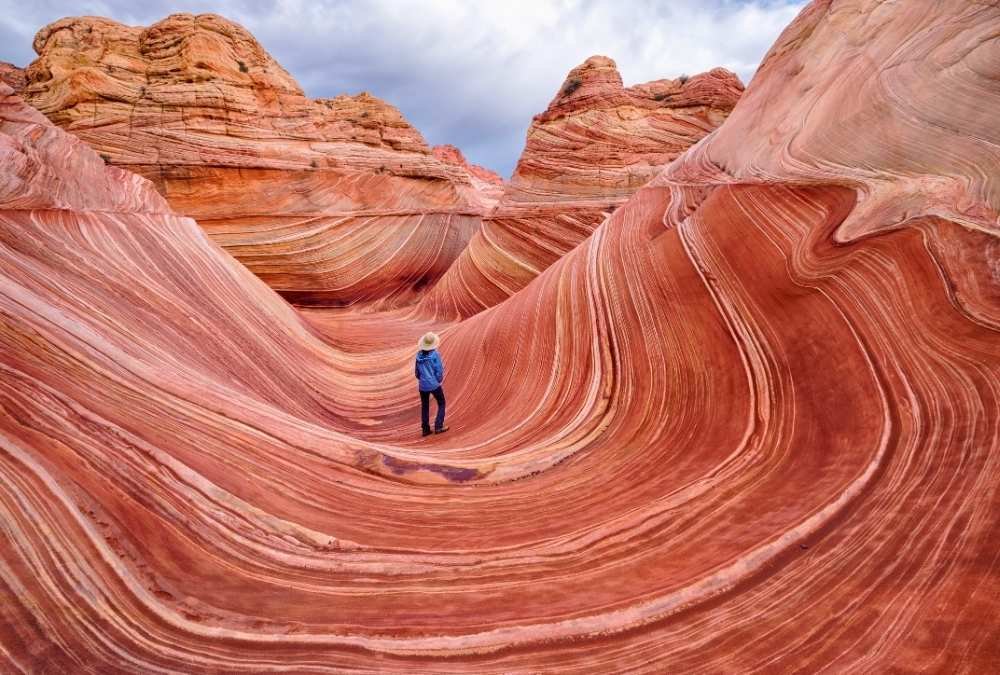
If you’ve ever dreamed of walking on another planet, The Wave in Arizona is as close as it gets. This surreal sandstone formation, nestled within the Vermilion Cliffs National Monument, looks like a liquid river of red and orange rock frozen in time. The undulating, striated sandstone creates an illusion of motion, and with every step, you feel like you’re trekking through an alien world.
Hiking The Wave is no walk in the park—it’s a 6.4-mile round trip across rugged terrain with no marked trail. But every drop of sweat is worth it. The colors shift throughout the day, with the sun casting a mesmerizing glow over the swirling rock formations. The real magic? The exclusivity. You can’t just waltz in—you need to win a highly competitive lottery permit to access this Martian paradise.
Once you’re standing in the heart of The Wave, it’s easy to forget Earth exists. No sound but the wind is whispering through the stone. It’s the kind of place that makes you pause, take a deep breath, and soak in the sheer magic of nature’s artistry. If Mars had hiking trails, they’d look like this.
Quick Facts & Travel Tips
- Best Months to Visit: March to May, September to November (cooler weather, best lighting for photography)
- Permit Required? Yes! Only 64 people per day are allowed, and you need to win a permit via an online or walk-in lottery.
- Hike Difficulty: Moderate to challenging (no marked trails, deep sand in some areas)
- Essential Tips:
- Bring GPS navigation—there are no signs!
- Carry at least 3 liters of water per person.
- Visit early or late in the day for the best lighting.
2. Wadi Rum, Jordan

Nicknamed the “Valley of the Moon,” Wadi Rum isn’t just Mars-like—it was a filming location for The Martian (2015). This sprawling desert of red dunes, towering cliffs, and bizarre rock formations looks so extraterrestrial that NASA has used it for Mars mission training. It’s one of those places where you half expect to see a Mars rover rolling over the next dune.
Hiking through Wadi Rum is an adventure. You can trek through canyons, scramble up towering sandstone mountains, or camp under a sky ablaze with stars. The landscape is constantly shifting—one moment, you’re wandering through vast, silent plains, and the next, you’re climbing rock bridges that defy gravity. If you’re up for a real challenge, try summiting Jebel Umm Ad Dami, Jordan’s highest peak. From the top, you can see into Saudi Arabia—talk about an epic view.
But what truly makes Wadi Rum unforgettable is the Bedouin experience. The nomadic Bedouins have called this Martian land home for centuries, and staying in one of their desert camps, sipping tea around a fire, and listening to their stories under the Milky Way? That’s the kind of memory that sticks with you forever.
Quick Facts & Travel Tips
- Best Months to Visit: October to April (avoid summer—it’s brutally hot!)
- Permit Required? Yes, but easy to obtain at the entrance.
- Hike Difficulty: Easy to difficult (depends on route; some require scrambling)
- Essential Tips:
- Hire a Bedouin guide—it’s the best way to explore.
- Bring a scarf or buff to protect from sandstorms.
- Stay overnight for the full experience—star-gazing is unreal!
3. Valle de la Luna, Chile
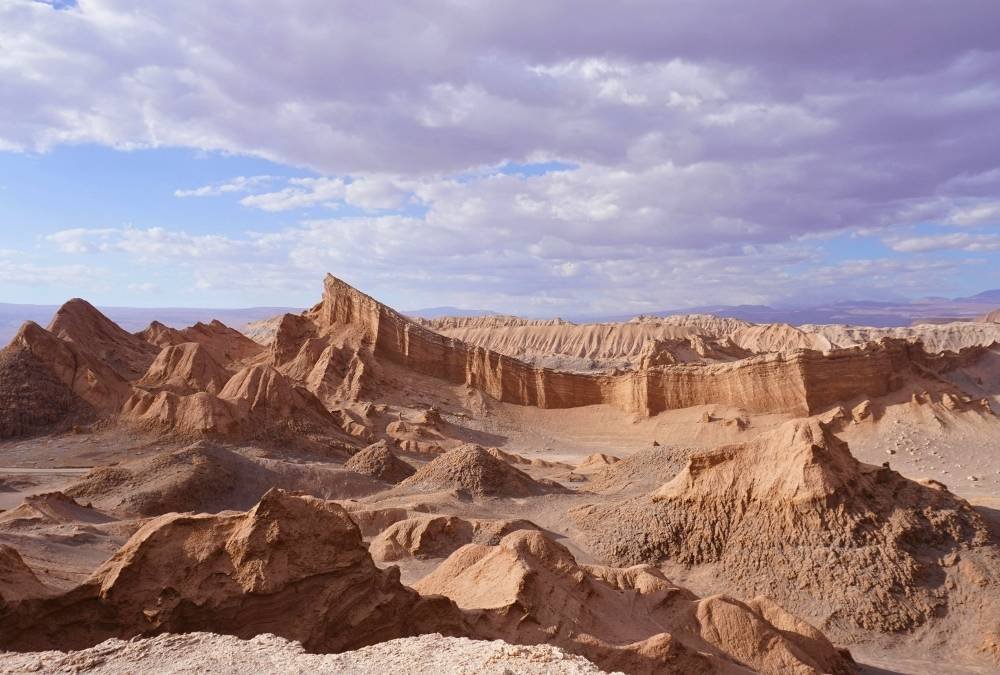
Tucked inside the Atacama Desert, the driest desert in the world, Valle de la Luna (Moon Valley) is so barren, so otherworldly, that it’s been used for Mars rover testing. The landscape is a mix of jagged salt formations, vast dunes, and craggy red rock that changes color as the sun moves across the sky. At sunset, it glows in hues of fiery orange and deep purple—almost too surreal to believe.
Hiking here is both eerie and exhilarating. There’s no life—no trees, no animals, not even a blade of grass. Just rock, sand, and silence. One of the best hikes takes you to Duna Mayor, a massive dune that offers a panoramic view of the entire valley. From up there, it feels like you’re standing on an alien planet, staring out at an endless sea of rust-colored hills.
But the real kicker? The sky in Valle de la Luna is some of the clearest on Earth. At night, the Milky Way is so crisp you can see individual stars without a telescope. It’s a humbling reminder of how small we are in the grand scheme of things.
Quick Facts & Travel Tips
- Best Months to Visit: March to November (December to February can be too hot)
- Permit Required? Yes, but easy to get at the entrance.
- Hike Difficulty: Easy to moderate (but hot during the day!)
- Essential Tips:
- Go for sunset—it’s breathtaking!
- Wear a hat and sunscreen—the sun here is intense.
- Stay in San Pedro de Atacama, the closest town.
4. White Pocket, Arizona, USA
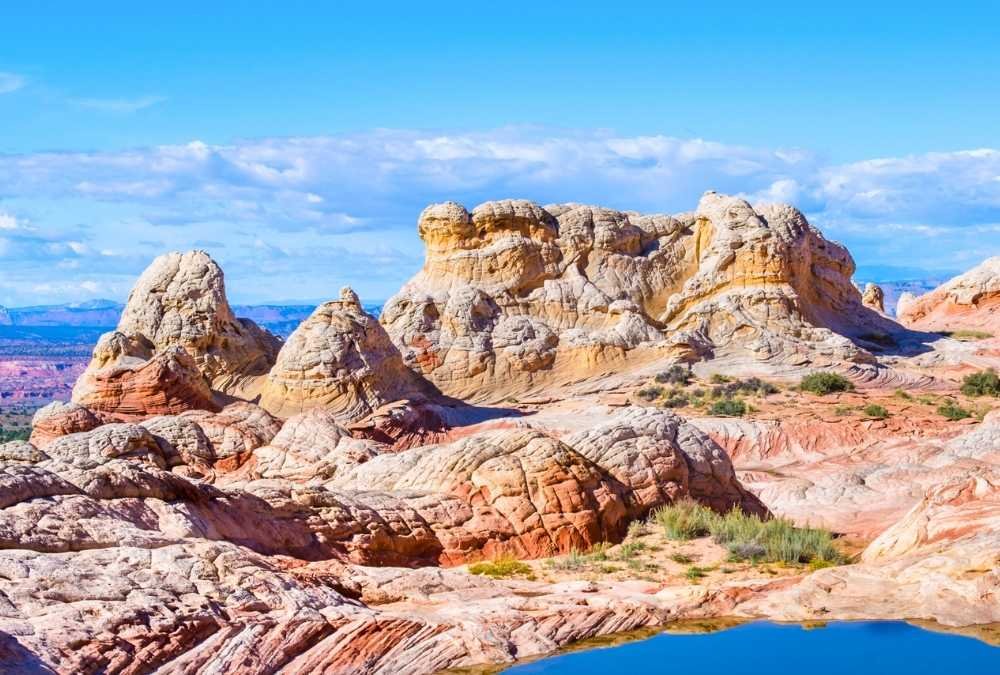
White Pocket is one of Arizona’s best-kept secrets. Unlike The Wave, you don’t need a permit, but getting there is no joke—you’ll need a high-clearance 4WD vehicle to tackle the deep sand roads. But if you can make it, you’re in for a sight straight out of a sci-fi movie.
This landscape looks like someone took The Wave, cranked up the contrast, and added a touch of lunar weirdness. The rock formations twist and swirl in reds, oranges, and whites, creating a psychedelic effect. Unlike other hikes, White Pocket is more of a “wander-at-your-own-pace” kind of adventure—there are no marked trails, just endless rocks to explore.
The best part? Almost no crowds. While The Wave is nearly impossible to get permits for, White Pocket is still a hidden gem. If you want a Mars-like experience all to yourself, this is the place.
Quick Facts & Travel Tips
- Best Months to Visit: Spring and fall (summer is too hot!)
- Permit Required? No, but you need a 4WD to get here.
- Hike Difficulty: Easy, but getting there is hard!
- Essential Tips:
- Bring a high-clearance 4WD or book a tour.
- No water sources—bring plenty!
- The best lighting is early morning or late afternoon.
5. Painted Desert, Arizona, USA
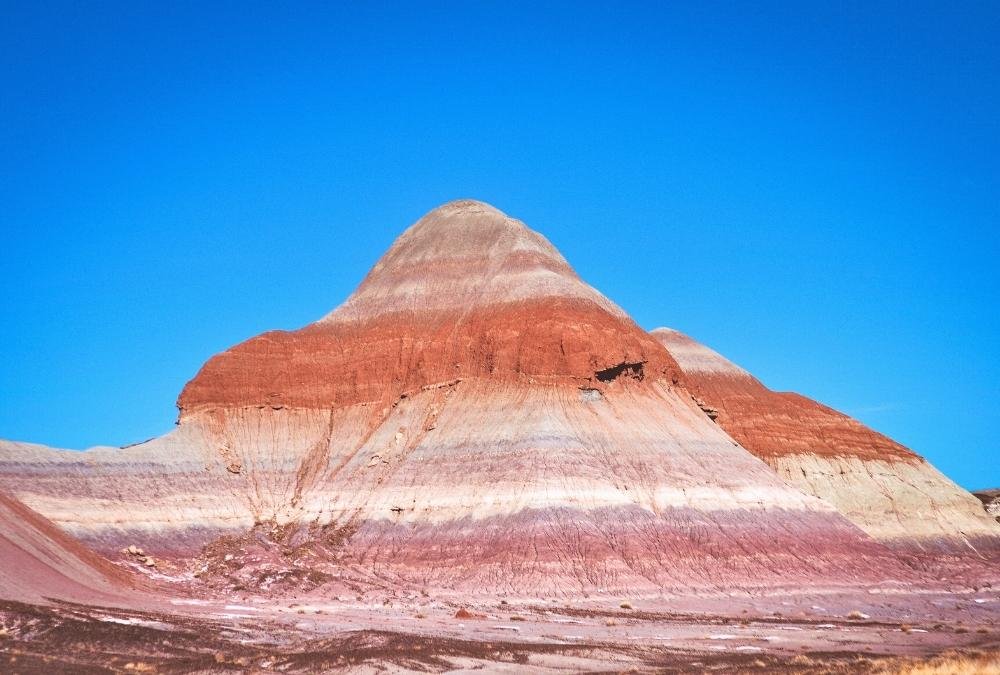
The Painted Desert is a dreamscape of pastel-colored badlands that stretch as far as the eye can see. It’s a mix of deep reds, purples, oranges, and soft pinks—like something straight out of a Mars sunset.
Most visitors only see it from the overlooks in Petrified Forest National Park, but the real magic is hiking into the heart of it. The Blue Mesa Trail is one of the best—it winds through bizarre bluish hills that look like they belong on another planet.
Unlike the brutal landscapes of Wadi Rum or The Wave, the Painted Desert feels more tranquil and meditative. It’s a place to slow down, soak in the views, and appreciate just how mind-blowingly beautiful Earth can be.
Quick Facts & Travel Tips
- Best Months to Visit: Spring and fall (summers are brutally hot!)
- Permit Required? No
- Hike Difficulty: Easy to moderate
- Essential Tips:
- Best explored at sunrise or sunset.
- No shade—bring sun protection!
- Stop by Petrified Forest National Park for even more alien landscapes.
6. Dallol, Ethiopia
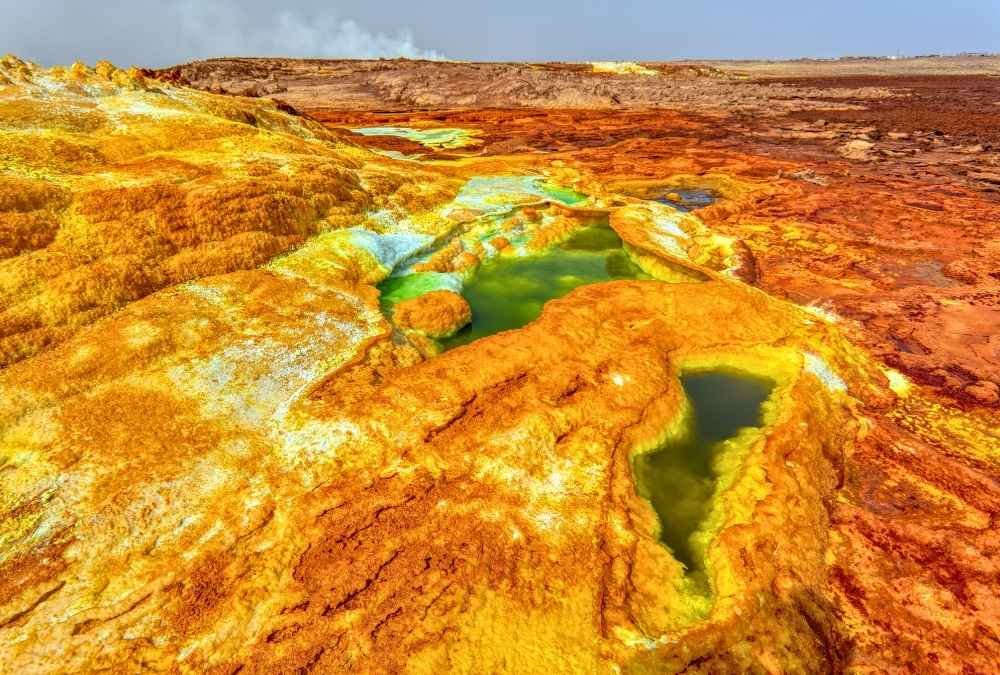
If there’s one place on Earth that truly looks inhospitable—like, straight-up toxic alien terrain—it’s Dallol in Ethiopia’s Danakil Depression. This place holds the record for the hottest inhabited location on Earth, with bizarre sulfur springs, acid pools, and neon-colored mineral deposits that make it look like a Martian chemical spill.
Hiking here feels surreal. The ground is a mix of rusty oranges, radioactive greens, and electric yellows, thanks to the extreme geothermal activity beneath the surface. Bubbling pools of acidic water and steaming geysers create an eerie, almost post-apocalyptic landscape. The air? Thick with the scent of sulfur, like a thousand rotten eggs mixed with hot metal.
But despite its extreme conditions, Dallol is one of the most fascinating places to visit. Scientists compare its conditions to early Mars, and NASA has even studied the microbes that thrive in its ultra-hostile environment. Hiking through Dallol is like stepping into a science fiction novel—except it’s all real.
Quick Facts & Travel Tips
- Best Months to Visit: November to February (summer is unbearable!)
- Permit Required? Yes, and you must have a guide.
- Hike Difficulty: Moderate (due to extreme heat and terrain).
- Essential Tips:
- Bring a face mask—the sulfur smell is intense.
- Stay hydrated—it’s one of the hottest places on Earth.
- Hire a local guide—they know the safe paths through the geothermal area.
7. Bisti/De-Na-Zin Wilderness, New Mexico, USA
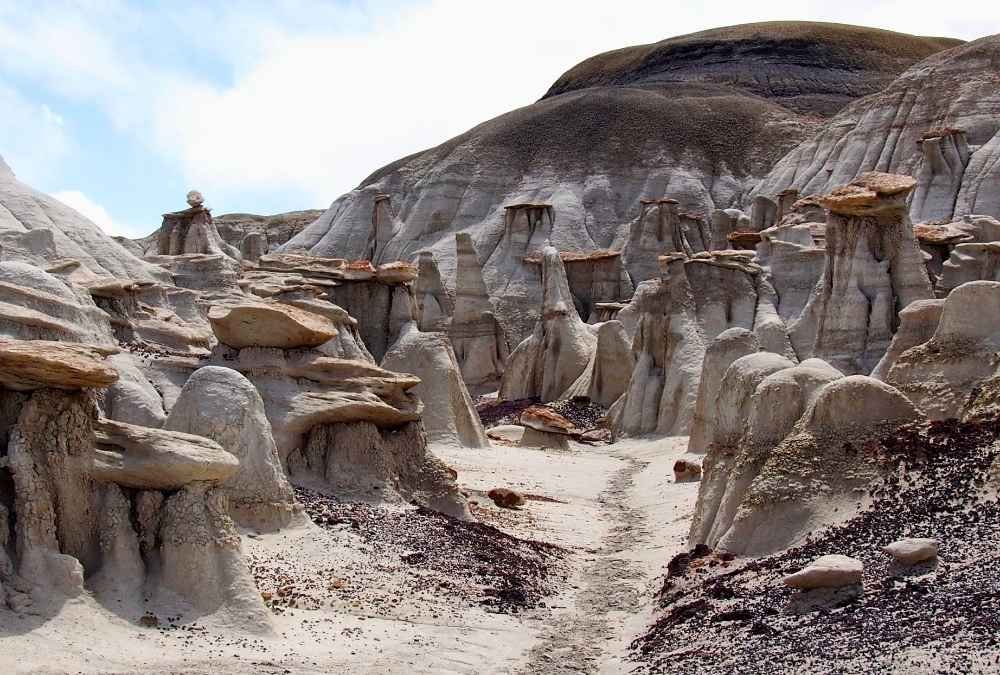
The Bisti/De-Na-Zin Wilderness, often called “The Bisti Badlands,” is one of those places that makes you feel like you’re trespassing on another planet. This remote landscape in New Mexico is full of eroded hoodoos, bizarre rock spires, and petrified wood, all shaped by wind and time into something eerily alien.
Unlike popular desert hikes, there are no trails, no signs, and no crowds—just an endless stretch of badlands waiting to be explored. You might stumble upon The Egg Factory, a collection of strange, cracked boulders that look like fossilized alien eggs, or the Stone Wings, delicate rock formations that seem to defy gravity.
One of the best things about Bisti? Absolute silence. No cars, no planes, no human noise—just the whisper of the wind. It’s the kind of place that forces you to slow down, take in the strange beauty, and appreciate just how wild and unpredictable nature can be.
Quick Facts & Travel Tips
- Best Months to Visit: Spring and fall (summers are scorching, winters can be cold).
- Permit Required? No, but there are no facilities or water sources—be prepared.
- Hike Difficulty: Moderate (no marked trails, navigation is key).
- Essential Tips:
- Use GPS or a physical map—it’s easy to get lost.
- Sun protection is a must—no shade anywhere.
- Go at sunrise or sunset for the most dramatic lighting.
8. Zabriskie Point, Death Valley, California, USA
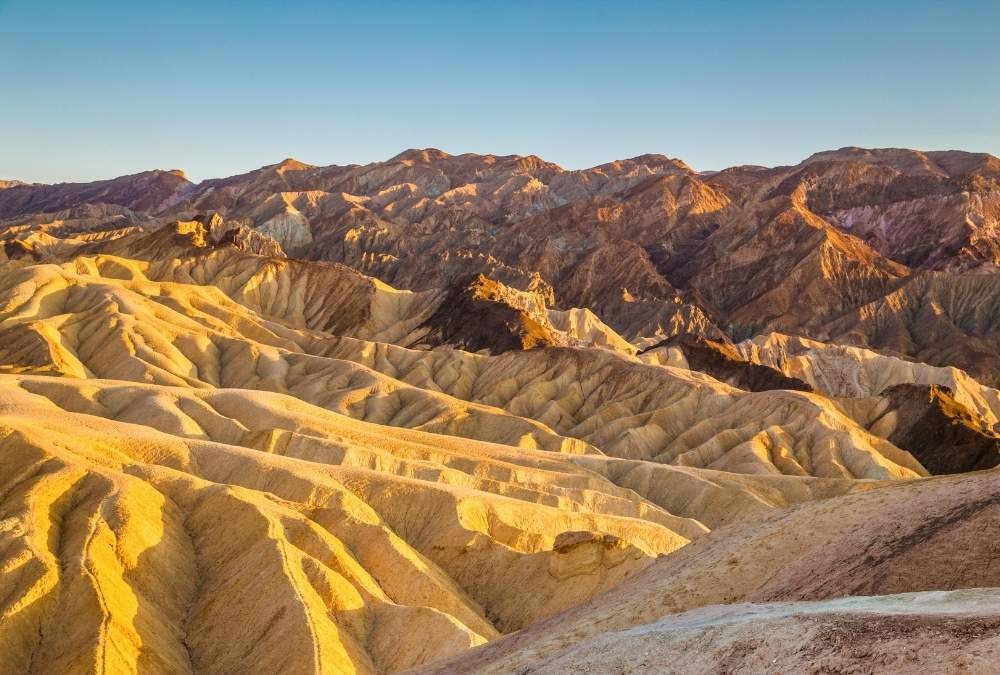
Death Valley is full of alien-looking landscapes, but Zabriskie Point takes the cake. Its rolling golden badlands, sculpted by erosion over millions of years, look like something straight out of a sci-fi film.
A short hike takes you up to a panoramic viewpoint, where you can see the dramatic maze of ridges stretching out in every direction. At sunrise or sunset, the soft light turns the hills into waves of gold, orange, and deep purple—a view so surreal it barely seems real.
If you’re up for a longer adventure, take the Golden Canyon and Gower Gulch Loop. This 6-mile trek winds through narrow canyons and colorful rock formations that feel eerily Martian. Just be careful in summer—Death Valley’s heat is no joke, and temperatures can reach a casual 130°F (54°C).
Quick Facts & Travel Tips
- Best Months to Visit: October to April (summers are dangerously hot!).
- Permit Required? No, but bring plenty of water.
- Hike Difficulty: Easy to moderate.
- Essential Tips:
- Go at sunrise or sunset for the best views.
- Avoid hiking here in summer—seriously, it’s deadly hot.
- Wear sturdy shoes—the loose gravel can be tricky.
9. Tassili n’Ajjer, Algeria

Tassili n’Ajjer is one of the least-explored but most mind-blowing desert landscapes on Earth. Hidden deep in the Sahara, this UNESCO-listed region is full of towering rock formations, deep canyons, and over 15,000 ancient petroglyphs dating back 12,000 years.
Hiking here feels like wandering through a lost world. The sandstone pillars, arches, and maze-like rock formations give the whole place a timeless, otherworldly vibe. Some of the formations look like giant stone mushrooms, others like enormous melted sculptures. Add in the silence of the Sahara, and it feels hauntingly beautiful.
The real magic? The prehistoric rock art. Some of the oldest known human artwork is hidden in the caves here, depicting ancient animals, humans, and mysterious symbols that hint at a time when this desert was once green and teeming with life. Hiking through Tassili isn’t just a physical journey—it’s a walk through deep history.
Quick Facts & Travel Tips
- Best Months to Visit: October to April (summers are brutally hot!).
- Permit Required? Yes, and a guide is mandatory.
- Hike Difficulty: Moderate to challenging (long treks, remote location).
- Essential Tips:
- Bring a guide—navigating solo is nearly impossible.
- Pack extra water and food—no services nearby.
- Don’t miss the ancient rock art—it’s mind-blowing!
10. Namib Desert, Namibia
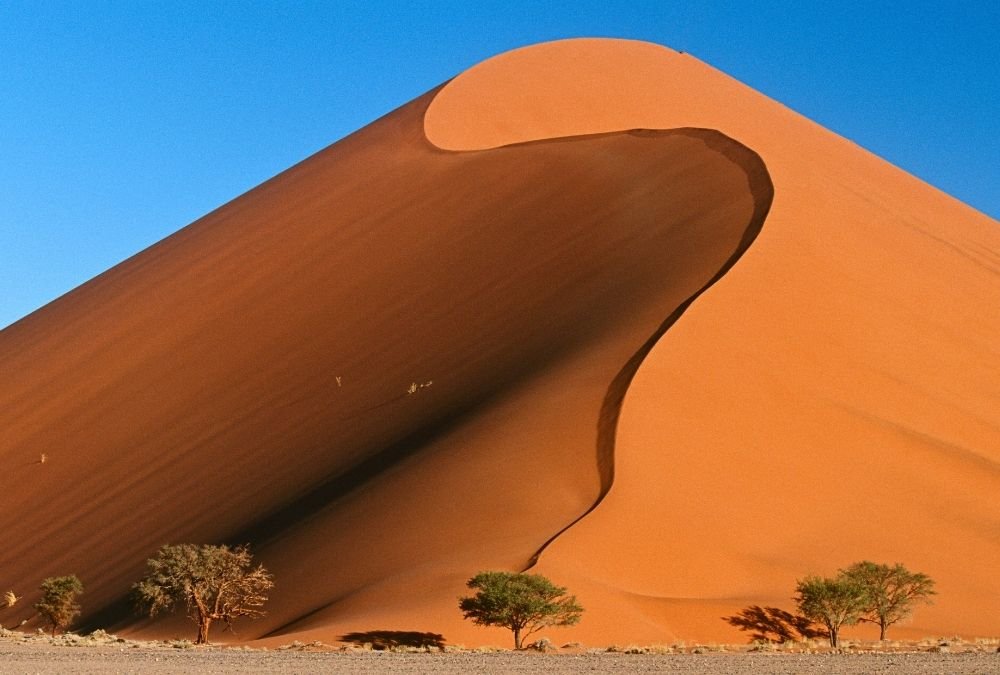
The Namib Desert is home to some of the tallest dunes in the world, and hiking them is like stepping onto an endless rolling sea of red and orange waves. If Mars had dunes, they’d look just like this.
One of the best hikes here is Big Daddy, a 1,066-foot (325m) monster dune in Sossusvlei. The climb is tough—the sand shifts beneath your feet, making every step feel like two—but the views from the top are unreal. From the summit, you can see an endless stretch of golden dunes, the eerie Deadvlei salt pan below, and even the Atlantic Ocean in the distance.
If you want something even weirder, check out Deadvlei, a surreal dried-up lake bed filled with blackened, ancient camel thorn trees that have been dead for centuries but never decomposed due to the extreme dryness. It’s a scene straight out of a dystopian sci-fi film.
Quick Facts & Travel Tips
- Best Months to Visit: May to September (cooler and less windy).
- Permit Required? Yes, for entering Sossusvlei.
- Hike Difficulty: Moderate to challenging (steep dunes).
- Essential Tips:
- Go early morning—hiking dunes in midday heat is brutal.
- Barefoot hiking works best in soft sand.
- Bring plenty of water—desert dehydration is real.
11. Socotra Island, Yemen
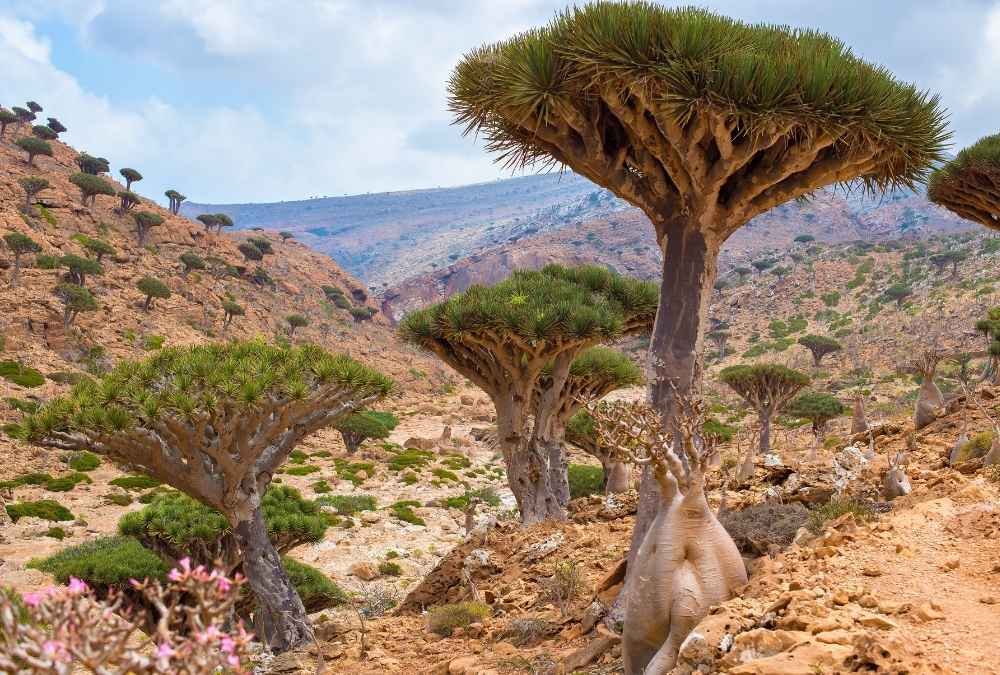
If aliens had a secret garden on Earth, it would be Socotra Island. This remote, otherworldly place in the Arabian Sea looks like a botanical fever dream, home to plants and landscapes that exist nowhere else on the planet.
The most famous sight? Dragon’s Blood Trees—weird, umbrella-shaped trees with thick, tangled branches that look like they belong in a sci-fi movie. Their red sap was once believed to be actual dragon’s blood (because why not?). Hiking here takes you through twisted limestone formations, deep gorges, and endless dunes, all while being surrounded by surreal flora. It’s like stepping into a completely different evolutionary timeline.
The remoteness of Socotra only adds to its mystique. There are no flashy resorts, no tourist crowds—just pristine, untouched wilderness. And at night? The sky is so dark and clear, it feels like the universe itself is putting on a private light show just for you.
Quick Facts & Travel Tips
- Best Months to Visit: October to April (summers are too hot and humid).
- Permit Required? No, but you need special travel arrangements due to remoteness.
- Hike Difficulty: Easy to moderate (depends on the trails you choose).
- Essential Tips:
- Bring cash—there are no ATMs on the island.
- Stay in eco-lodges or camp—no big hotels here!
- Try the local honey—Socotra is famous for it.
12. Lençóis Maranhenses, Brazil
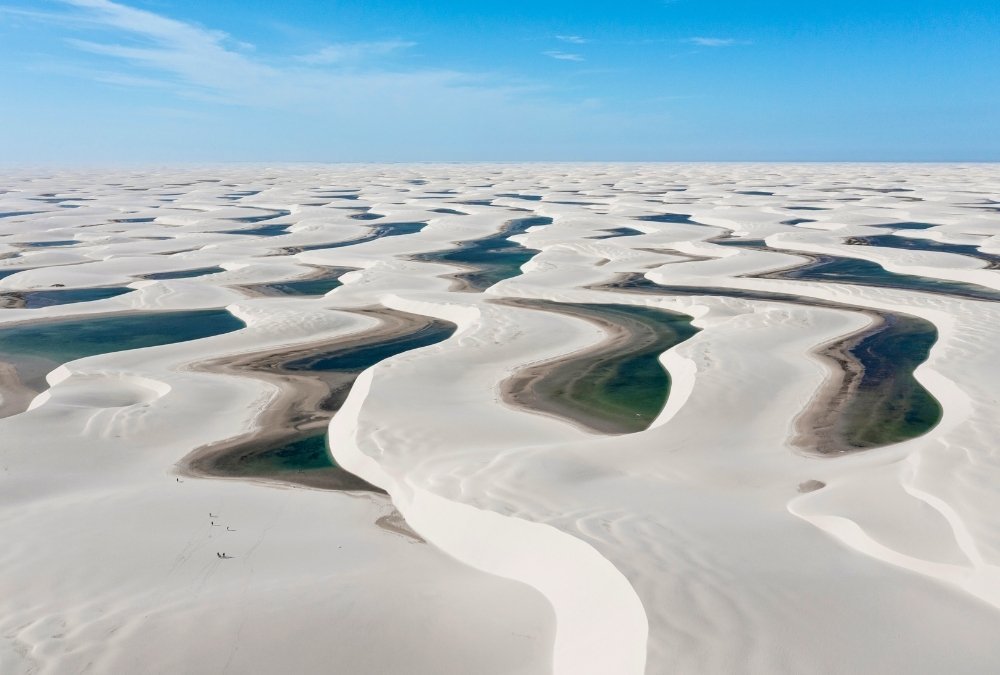
Imagine walking across an endless expanse of white dunes—but instead of just dry sand, you’re surrounded by crystal-clear blue lagoons. That’s Lençóis Maranhenses, a place so bizarre and breathtaking, that it feels more like a hallucination than reality.
This national park in northern Brazil is famous for its seasonal rainwater lagoons, which form between massive dunes during the wet season. The contrast between the bright white sand and the shimmering blue pools is unreal—like something you’d expect to see on another planet. And the best part? You can swim in these natural desert lakes!
Hiking here is both strange and spectacular. Unlike most desert treks, you’re constantly shifting between soft sand and refreshing dips in warm, clear water. The landscape changes daily, depending on the wind and water levels, meaning no two visits are the same. If there’s a more magical desert on Earth, we haven’t found it yet.
Quick Facts & Travel Tips
- Best Months to Visit: June to September (when the lagoons are full).
- Permit Required? No, but a guide is recommended.
- Hike Difficulty: Moderate (walking on soft sand is tiring!).
- Essential Tips:
- Wear water-friendly shoes—you’ll be walking and swimming.
- Visit during the late afternoon—the sunset over the dunes is breathtaking.
- Stay in Barreirinhas or Atins—the best bases for exploring.
13. Atacama Desert, Chile
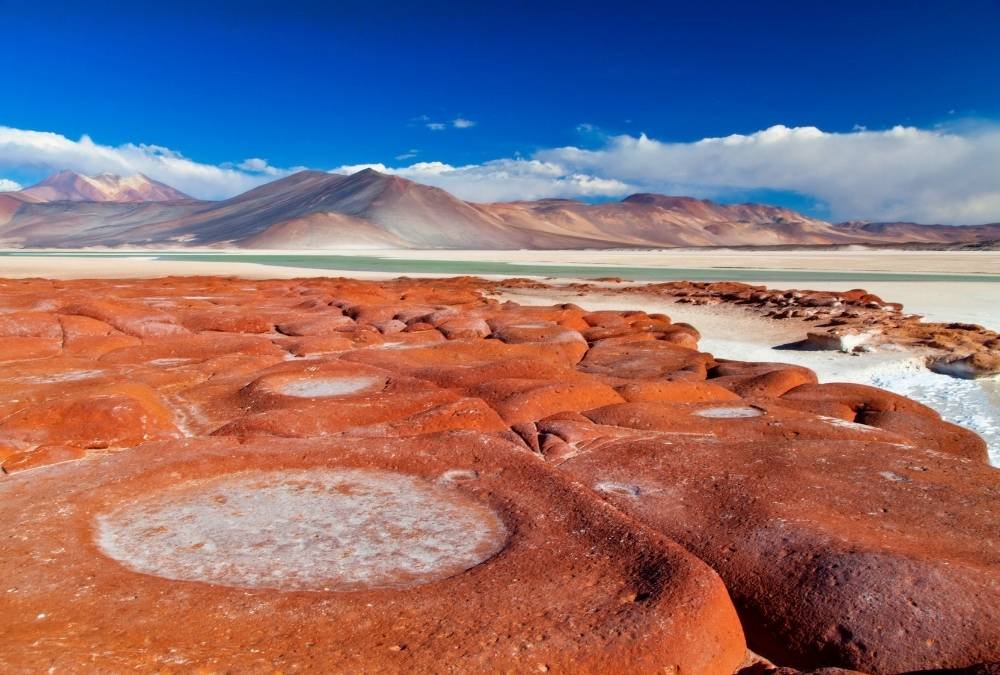
They say if you want to feel like you’re on Mars without leaving Earth, the Atacama Desert is the place to be. With its rust-red landscapes, salt flats, and geysers puffing steam into the thin, dry air, it’s no wonder NASA uses this region to test its Mars rovers.
Hiking in the Atacama feels epic. One moment, you’re walking across cracked desert plains, the next, you’re staring at towering volcanoes and surreal rock formations shaped by the relentless wind. If you’re up for a real challenge, trek to the Tatio Geysers at sunrise, where boiling steam erupts from the Earth like something out of a sci-fi movie.
But the real magic happens after dark. The Atacama Desert is home to some of the clearest night skies on Earth, making it one of the best stargazing spots in the world. Lay back, stare up, and feel like you’ve left the planet entirely.
Quick Facts & Travel Tips
- Best Months to Visit: March to November (cooler and better for hiking).
- Permit Required? No, but some areas require a small entry fee.
- Hike Difficulty: Easy to challenging (depends on the trail).
- Essential Tips:
- Bring layers—days are hot, nights are freezing.
- Don’t skip the Valle de la Luna—it’s unreal.
- Book a stargazing tour—this is an astronomer’s paradise.






